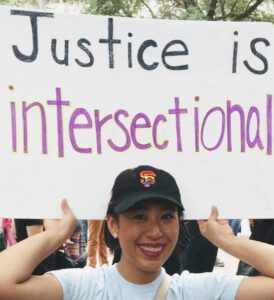March 23, 2021
Finding Hope in Visibility
Senior Director of Chapters
Part of a special series recognizing Women’s History Month

The ongoing and persistent hate, dehumanization, violence, and Othering has been overwhelming. This violence is not new. White supremacy, misogyny, and racism is ingrained in our country’s founding. This hate manifests itself in a multitude of ways to oppress, suppress, hurt, and kill communities that are Othered, including BIPOC communities, the LGBTQ+ community, and religious minorities.
In the last month, and especially in response to the tragic shootings in Atlanta, I am seeing something that I have never seen before in the news or in popular culture:
- Discussions on anti-Asian animus and linking that animus to the broader fight against white supremacy;
- A retelling of U.S. history that includes not only the Chinese Exclusion Act and Japanese Internment, but also the contributions of Asian Americans to American history including the 442nd Regiment, a segregated Japanese-American unit that is remembered today for its bravery in World War II and for being the most decorated unit in American history, and the work of AAPI leaders like Yuri Kochiyama and Larry Itliong who fought for liberation alongside Malcolm X, Cesar Chavez, and Dolores Huerta; and
- Discussion on the ways “race, gender, and national origin interact to create unique obstacles, stereotypes, and stigmas for Asian American women.”
I came across a Buzzfeed article, “Asian Women Are Hypersexualized, So Don’t Tell Me The Killings In Atlanta Aren’t About Race,” and it stopped me in my tracks. That astonishment happened again when I came across NPR’s “For Asian American Women, Misogyny And Racism Are Inseparable, Sociologist Says.” These articles challenged the public to not only see last week’s attacks as motivated by the interaction of both race and gender, but also educated its readers about the unique oppression and violence that Asian American women face because of the dehumanizing fetishization, hyper-sexualization, and exotification of Asian American women. These articles validated my experiences and made me feel “seen” in a way that I had not experienced before. It also encouraged me to lift up my own work in this space.
As a first-generation Taiwanese American, I can recount multiple instances of friendly neighbors and do-gooders complimenting me on my English, finding me in a crowd to tell me about their recent trip to Asia, and asking me where I am really from. As an Asian American woman, I’ve also been subjected to inappropriate comments alluding to the fetishization and perceived submissiveness of Asian American women. These dehumanizing comments, the failure to see myself and my experiences reflected in discussions of the “glass ceiling” and the “bamboo ceiling,” and my desire to shed more light on the history of exclusion for Asian American women led me to publish “Hitting the Ceiling: An Examination of Barriers to Success for Asian American Women” in the Berkeley Journal of Gender, Law & Justice in 2014. In it, I argue that the “bamboo ceiling” and the “glass ceiling” necessarily excludes the experiences of Asian American women since the “discrimination faced by Asian American women is wholly different from and more than the sum of the discrimination faced by white women and Asian American men.” Instead, “[t]o comprehend the experiences of Asian American women and create appropriate strategies for counteracting their oppression, we must look at how race, gender, and national origin interact to create unique obstacles, stereotypes, and stigmas for Asian American women. Intersectionality provides a framework to analyze [these experiences].” To better understand the unique experiences of Asian American women, my article recounts the history of exclusion of Asian American women in the United States from The Naturalization Act of 1790, the Page Law, and the Chinese Exclusion Act, to Japanese Internment. I also discuss the immigration patterns of Asian women. During the nineteenth century (and until the 1920s), very few Asian women entered the United States. Those that were allowed entry came to meet the demands for sex from both white men and Asian men. This led to the emergence of sexual stereotypes about Asian women as ultra-feminine, subservient, “lotus blossoms,” and “dragon ladies.” After discussing the history of these stereotypes, including modern manifestations of these stereotypes in film and television, I examine the Model Minority Myth, how it serves to further oppress Asian American communities and other communities of color, and how it puts Asian American women at an increased risk of sexual harassment. The rest of the article discusses how these stereotypes have contributed to discrimination and sexual harassment against Asian American women in the workplace, provides the standard for proving unlawful employment discrimination and an overview of employment discrimination cases brought by African American women and Asian American women, and illustrates the need for courts to embrace an intersectional and holistic approach to employment discrimination claims.
These past few months have been emotionally and physically exhausting. I am heartbroken, enraged, and overwhelmed by the attacks against Asian American elders, the shootings in Atlanta, and the barrage of violence against communities of color. But in this darkness, I also feel oddly hopeful. In the last few weeks, I have seen conversations and articles that weave Asian American experiences into the tapestry of American history and into the discussion of race in America. We have a long way to go, but we must continue to move forward, speak up, speak out, and get uncomfortable. To continue to move forward, we cannot treat these violent acts as isolated incidents perpetrated by individual bad actors. Instead, we must confront and acknowledge how this current wave of violence is inextricably linked to our country’s deeply rooted history of white supremacy and misogyny, be accountable for how we each contribute to white supremacy and misogyny, commit to truth-telling and education, and engage in reconciliation.
Equality and Liberty, Gender Equality, Racial Justice, Women's rights




